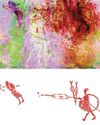
IN THE VILLAGE OF GONGDONG outside the central Chinese city of Xi’an, construction projects have kept archaeologists busy since the summer of 2020. Thus far, more than 100 ancient tombs have been uncovered in the area, some dating to as early as the Han Dynasty (206 B.C.–A.D. 220). Last June, a team of archaeologists from the Shaanxi Academy of Archaeology unearthed a large Tang Dynasty (A.D. 618–906) family tomb at Gongdong. Classical Chinese culture flourished during the Tang Dynasty, and elite tombs dating to that period are known for their intricate stone- and brickwork and are often filled with numerous artifacts. The newly discovered tomb, belonging to a military commander named Yuan Daqian and his wife, Luo Wanshun, was no different. Archaeologists found more than 100 ceramic vessels and figurines in the multichambered tomb, despite the fact that tomb raiders had looted it in antiquity.
Tang Dynasty ca. A.D. 700
One discovery stood out from the rest. In elite Chinese tombs, archaeologists often find square funerary stones, referred to as epitaphs, that are inscribed with ornate calligraphy that relates the accomplishments of the dead at length. The epitaphs are accompanied by stone plaques known as epitaph covers bearing brief descriptions of the tomb’s occupant. Epitaph covers and epitaphs were typically wrapped together in silk and placed near the front entrance to the main room of tombs, where the dead were interred—but in this tomb they had been pushed aside. “When we entered the couple’s tomb, we saw that the epitaphs and epitaph covers had been displaced by tomb raiders,” says Shaanxi Academy of Archaeology scholar Zhang Yanglizheng.
Bu hikaye Archaeology dergisinin January/February 2022 sayısından alınmıştır.
Start your 7-day Magzter GOLD free trial to access thousands of curated premium stories, and 8,500+ magazines and newspapers.
Already a subscriber ? Giriş Yap
Bu hikaye Archaeology dergisinin January/February 2022 sayısından alınmıştır.
Start your 7-day Magzter GOLD free trial to access thousands of curated premium stories, and 8,500+ magazines and newspapers.
Already a subscriber? Giriş Yap

A Very Close Encounter
New research has shown that human figures painted in red on a rock art panel in central Montana depict individuals engaged in a life-or-death encounter during an especially fraught historical moment.

A Sword for the Ages
A zigzag pattern, now tinged with the green-blue patina of oxidized metal, adorns the octagonal hilt of a rare sword dating to the Middle Bronze Age in Germany (1600-1200 B.C.) that was recently excavated in the Bavarian town of Nördlingen.

Ancient Egyptian Astrology
For centuries, layers of soot have coated the ceilings and columns in the entrance hall of Egypt's Temple of Esna. Now, an Egyptian-German team of researchers, led by Hisham El-Leithy of the Egyptian Ministry of Tourism and Antiquities and Christian Leitz of the University of Tübingen, is restoring the temple's vibrant painted reliefs to their original brilliance.

BRONZE AGE POWER PLAYERS
How Hittite kings forged diplomatic ties with a shadowy Greek city-state

RITES OF REBELLION
Archaeologists unearth evidence of a 500-year-old resistance movement high in the Andes

Secrets of Egypt's Golden Boy
CT scans offer researchers a virtual look deep inside a mummy's coffin

When Lions Were King
Across the ancient world, people adopted the big cats as sacred symbols of power and protection

UKRAINE'S LOST CAPITAL
In 1708, Peter the Great destroyed Baturyn, a bastion of Cossack independence and culture

LAPAKAHI VILLAGE, HAWAII
Standing beside a cove on the northwest coast of the island of Hawaii, the fishing village of Lapakahi, which is surrounded by black lava stone walls, was once home to generations of fishers and farmers known throughout the archipelago for their mastery of la'au lapa'au, or the practice of traditional Hawaiian medicine. \"

A MORE COMFORTABLE RIDE
Although the date is much debated, most scholars believe people 5,000 years ago. For thousands of years after that, they did so without saddles. \"In comparison with horse riding, the development of saddles began relatively late, when riders began to care more about comfort and safety in addition to the horse's health,\" says University of Zurich archaeologist Patrick Wertmann.